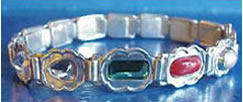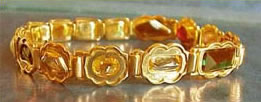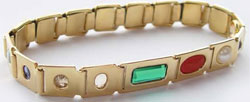|
|||||||
 |
 |
 |
 |
|
Frequently Asked Questions What type of Gold or Silver do you recommend for your arm bangles or rings? When we make our astrological ayurvedic gem bangles in silver, they are composed of STERLING SILVER which is 92.5% SILVER and 7.5% COPPER. Pure noble metals have a subtle benign frequency; the purer the metal, the more benefit there is to the wearer. Fine silver is too soft to use in the gem-mounted part of the bangle, it would not be durable. But the expandable spring links which make up the other portion of the arm bangle are available in both sterling silver and an extra thick walled pure silver version. We generally use the sterling silver spring links at $25 each, but upon request we will supply the customer with the pure silver spring links at the price of $38 each (as of January 2013). When we make a gem bangle in gold, we always use 22 karat gold. Pure 24 karat gold is too soft for durable construction. We can make custom bangles in gold using less purity such as 14 karat gold, etc. but the expense is not justified, in our opinion, as the extra alloy neuters the ayurvedic properties of the gold. As is the case with silver, extra thick walled spring links can be made in 24K gold. Astrogems always recommends alloys that use noble metals only. Silver, copper, and gold are noble metals and have harmonizing influences on the electrical body, whereas we have found nickel and zinc not to be as benign. We are quite different to most jewelers who do not have control over the casting process and tend to use metals with zinc, nickel and/or cadmium in the alloys. CARAT or KARAT: The word has 2 meanings. Referring to diamonds and gems, a carat is a unit of weight equal to 1/5 of a gram. Referring to gold purity, one karat is 1/24 part. So 24kt is pure gold, 18kt is 18/24 or 75% gold, etc. Karat golds are alloys of gold with other metals. There are different standards throughout the world. 18kt is commonly used in Europe. Other commonly found ones are: 10, 14, 22kt. Gold is very soft unless alloyed. The alloys are also used often to vary the properties and color of gold (rose gold, for example).
Please note that silver from countries such as Nepal and India commonly has Cadmium in it and that this metal has legal restraints in the EU due to its toxicity. ANNEALING: Metals have a crystalline structure. When a metal is strained and distorted mechanically, the crystals become stressed and the metal hardens. To relieve this stress, and "relax" the structure, they must be heated to a temperature somewhat below the melting point. This is called annealing. Gold alloys must be cooled slowly after annealing. Our bangles are made in such a way that they can last a lifetime and will not need annealing. MALLEABILITY: Describes how the metal deforms under impact from a hammer or punch. After annealing, gold is generally quite ductile (soft). Fine 24 kt gold is softer than lesser karat gold alloys. Deforming metals by pressure or impact causes them to harden at differing rates dependent on the alloy. As it hardens, it becomes less deformable, and more brittle. Most alloys containing copper will age-harden. This may be apparent over months to years. WEAR: The wear resistance is related to its surface hardness and age as well as to the actual metal. For example, the annealed hardness of 10 & 18 kt golds are similar. 18, 14, 10 kt golds are considerably harder than 22 or 24 kt gold. Annealing softens them, and working (bending, twisting) tends to work harden metals (this explains why forged steel is much stronger than cast steel for the same alloy content). SOME OTHER TRIVIA: 130,000 tons of gold have been mined so far (only 15% of this is missing). 42% of known gold lies in Central Banks. Return to Frequently Asked Questions |

|
If you would like to help others by offering our Free 16 page Vedic horoscope to be emailed to your website visitors we are happy to help you to put it up on your website. Please feel most welcome to contact us at [email protected] It's a great way to make your website more dynamic. |
